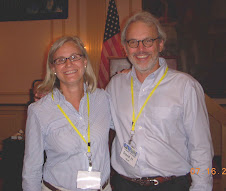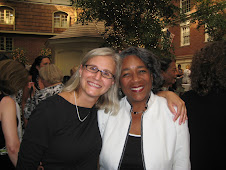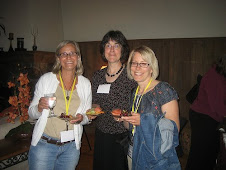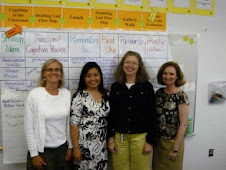In preparation for the GRAD reading test that all sophomores will take next April, I have begun working with the Chemistry Foundations teachers to add more reading to their sophomore class. If the science teachers use the same reading terms (e.g. literal, inference) when discussing articles read for class as appear on the GRAD reading test, students, hopefully, will have a better grasp of what the test questions are asking.
I developed a sheet for the science teachers that list the three stages of questions. I modeled the sheet after the one English 10 teachers are using for even more consistency across the curriculum when discussing reading. If both classes employ a similar framework with common GRAD test terminology, the students should start seeing connections. Enriched English 10 used a similar three-stage question framework for poetry analysis this week, and I'm confident that standard English 10 will be able to implement the question stages during a poetry unit just prior to the GRAD reading test.
Below are the stages for science that have many of the question stems that are on the Minnesota GRAD reading test.
Science Stage 1 Questions (Literal)
Summarize the article.
Paraphrase the article.
What are the main ideas and supporting details?
What do words mean in context?
What is the text structure?
What is the point of view—first person or third person?
Science Stage 2 Questions (Inference)
What is the purpose of this article?
What tone does the author establish in the article?
What are the connotations of words?
What figurative language, such as metaphor, simile or symbol, is used?
How does the structure enhance the meaning?
What are facts and what are opinions in the piece?
Is there any bias in the text?
Is the information in the article credible, or is it contradicted elsewhere in the text or does it contain logical fallacies?
Is there any satire in the piece?
Science Stage 3 Questions (Constructed Response)
What connections did you make between the article and science class?
What personal connections can you make with the piece?
What connections to the world today are you making?
Compare the ideas from the piece to other books, films and pop culture.
Below is the list of poetry questions by stage with questions that correspond to the wording of the Minnesota GRAD reading test questions.
Poetry Stage 1 Questions (Literal)
Paraphrase the poem.
What are the main ideas?
What do words mean in context? (Denotation)
Who is the narrator?
What is the text structure?
What are facts and what are opinions in the piece?
Poetry Stage 2 Questions (Inference)
What is the theme or life lesson of the poem?
What is the poet’s tone?
What are the connotations of words?
What figurative language, such as personification, metaphor, simile, imagery, and symbol, is used?
How does the rhyme scheme and structure enhance the meaning?
Poetry Stage 3 Questions
What personal connections can you make with the poem?
What connections to the world today are you making?
Compare the poem to other books, films and pop culture.
Sunday, October 28, 2007
Friday, October 26, 2007
Final Word Timer
Jim Hatten used the final word protocol twice this past unit with his sophomore English class and felt it went well. His sophomores discussed an article on cheating and then an article on environmental threats. Jim's also planning on using final word with his senior journalism class.
Jim projects a timer on his screen so that students can keep track their talking time.
Click here for a free, classroom timer to use on your computer.
Teachers with Interwrite pads also have a classroom timer as part of their gallery teaching tools. Projecting a classroom timer has a variety of uses to assist with classroom management.
Jim projects a timer on his screen so that students can keep track their talking time.
Click here for a free, classroom timer to use on your computer.
Teachers with Interwrite pads also have a classroom timer as part of their gallery teaching tools. Projecting a classroom timer has a variety of uses to assist with classroom management.
Labels:
classroom management,
final word,
language strategies,
reading
Wednesday, October 24, 2007
Outside Reading Thinking Maps
Jim Hatten created a comprehensive assessment using Thinking Maps for his sophomore English class. His students create four Thinking Maps on the memoir that they read outside of class. This activity replaces a traditional literary analysis essay.
Jim created a website to help his students understand ways that they could use each Thinking Map to show their understanding of the book that they read. Since students were able to choose which four maps to use, the website helped students explore their options.
Click here to explore Mr. Hatten's website.
Jim created a website to help his students understand ways that they could use each Thinking Map to show their understanding of the book that they read. Since students were able to choose which four maps to use, the website helped students explore their options.
Click here to explore Mr. Hatten's website.
Labels:
brace map,
circle map,
cognition,
double bubble,
flow map,
multi-flow,
reading,
thinking maps,
tree map
Character Development with a Double Bubble Map
English teacher Kristin Benson submitted the following assessment that her eleventh graders in American Literature will complete as the final test on a choice book that they read outside of class.
Outside Reading Quarter 1 -Young Adult Literature
One of the trademarks of young adult literature is that the protagonist or main character is typically a teenager who comes of age. That is, he or she is faced with challenges that result in some sort of change, learning or growth. Here is your chance to show what you’ve learned about your main character.
Part I: Create a Double Bubble Map
Create a double bubble map comparing your character at the beginning of the novel to your character at the end of the novel. (See board for example). Fill the bubbles with phrases or words that describe his or her attitudes, ideas and beliefs. You should offer a minimum of 3 similarities and 3 differences. You may also exceed expectations and do more.
Part II – Explain the ideas in your double bubble map
In a well-organized paragraph, explain how your character grows, matures or comes of age in this novel. You should provide at least two specific examples from the text to support your ideas. If you brought your book to class you may use it to provide direct quotations with page numbers. Remember to include a topic sentence, context for your quotes, examples from the text, analysis that connects to your topic sentence and a concluding sentence that sums up your ideas. (You may write on this sheet or on lined notebook paper, if you prefer)
Outside Reading Quarter 1 -Young Adult Literature
One of the trademarks of young adult literature is that the protagonist or main character is typically a teenager who comes of age. That is, he or she is faced with challenges that result in some sort of change, learning or growth. Here is your chance to show what you’ve learned about your main character.
Part I: Create a Double Bubble Map
Create a double bubble map comparing your character at the beginning of the novel to your character at the end of the novel. (See board for example). Fill the bubbles with phrases or words that describe his or her attitudes, ideas and beliefs. You should offer a minimum of 3 similarities and 3 differences. You may also exceed expectations and do more.
Part II – Explain the ideas in your double bubble map
In a well-organized paragraph, explain how your character grows, matures or comes of age in this novel. You should provide at least two specific examples from the text to support your ideas. If you brought your book to class you may use it to provide direct quotations with page numbers. Remember to include a topic sentence, context for your quotes, examples from the text, analysis that connects to your topic sentence and a concluding sentence that sums up your ideas. (You may write on this sheet or on lined notebook paper, if you prefer)
Labels:
cognition,
double bubble,
language strategies,
thinking maps,
writing
Tuesday, October 16, 2007
Advanced Placement and Final Word Discussion
Lonni Skrentner, retired AP history teacher, submitted the following information about using the Final Word Discussion with her advanced placement students.
My favorite NUA strategy in Advanced Placement was “Final Word Discussion.” In that strategy, students read an article (something biased or analytical works best). While reading, they highlight sections (no more than two or three lines each) that they think are important, interesting, about which they have questions. I tell them to number the highlights they want to share – 1-2-3, so they have at least two back ups when someone in their group shares their highlight before it is their turn.
Using a deck of cards, “deal” your students into groups of no more than four. You decide which “suit” starts (you’ve culled your deck to include just enough cards for your class – so a class of 12 would only need aces, twos and threes – for an odd number choose a joker and let them pick a group to join). Tell groups their goal is decide on one highlight and a back-up to share with the whole class. Then the strategy works as follows:
My favorite NUA strategy in Advanced Placement was “Final Word Discussion.” In that strategy, students read an article (something biased or analytical works best). While reading, they highlight sections (no more than two or three lines each) that they think are important, interesting, about which they have questions. I tell them to number the highlights they want to share – 1-2-3, so they have at least two back ups when someone in their group shares their highlight before it is their turn.
Using a deck of cards, “deal” your students into groups of no more than four. You decide which “suit” starts (you’ve culled your deck to include just enough cards for your class – so a class of 12 would only need aces, twos and threes – for an odd number choose a joker and let them pick a group to join). Tell groups their goal is decide on one highlight and a back-up to share with the whole class. Then the strategy works as follows:
- First person shares a highlight with their rationale or question
- Each other person in the groups reacts to that person (I don’t get what you mean, I highlighted the same thing but because... etc.)
- The speaker gets the “final word,” a reaction to what their peers have said.
- Next person goes and so on.
- They decide which highlight they want to share in the large group – who will read, who will explain etc.
- Bring the class back together as soon as you realize most groups are finished sharing (with adults this strategy needs a timer because they will go on talking, but teens will probably be able to go twice around the group in 15 minutes or so!)
- Have each group share one highlight (make sure they say page number, column and approximate spot so students can follow along) – as teacher ask some clarifying, analytical or further descriptive questions.
Got questions? Want to brainstorm? Get a coach or colleague to sit down with you. Call Lonni Skrentner, retired EHS social studies teacher (952-946-1173, skrents@aol.com) and she’d be glad to come in on an off day during your prep.
Advanced Placement and Thinking Maps
Lonni Skrentner, retired AP history teacher, submitted the following information about using thinking maps with her advanced placement students.
Thinking Maps
Most folks see NUA strategies and maps as tools for use with struggling students. I discovered they were phenomenal for use in Advanced Placement. The maps can be used for analysis, review and essay creation. A useful idea is to allow students to choose a map to use whatever the assignment. It seemed that students had “favorite” maps that they used well.
For analysis, you choose the concept or question and the students (usually in pairs) choose a map. Most students are tech savvy enough to draw a map in Word, Paint or PowerPoint programs. The maps can be emailed to the teacher one day in advance of class use or brought on a memory stick to load. So you make the due date one day early essentially. Create a folder within your documents and save by hour or just as a jumble together. When you put the map up on the screen, students “present” their ideas.
Good questions to use with class are:
Is there anything on this map that is outright wrong?
Why is it wrong? Creators – what led you to put it there?
Are there things you would add to this map? What? Why?
You probably won’t have time to use all student maps, and some may not be worth using. To grade this type of assignment, make sure you use a student’s map sometime within a unit and grade them for that presentation – that way you are not grading everyone each time.
For review, the field is more wide open. The most thoughtful review I found, simply puts the Unit in the center of a Circle-Frame Map. Some students began dividing the descriptive circle into arcs and putting topics like “political, economic, social” in them with specifics. The most important piece was the presentation of the outer frame – with the following question:
What forces created the specifics of this unit? (Obviously, you would make the question more descriptive to the unit!)
I also told students that they could combine maps in order to describe the unit. Sometimes you could use “Mapmaker Man” (See Jackie Roehl if you haven’t met “him,” though I don’t think there is an electronic version.) Again, electronic submission is the key to being able to use them in class – you save the maps (a day early!)
Essays are the toughest “gig.” I created maps for the two types of AP World History essays and they really helped some students. I never really figured it out for APUSH, though. I had students map the topics for essays – which worked well. Someone needs to figure out the “stems" for APUSH essays and then map templates could be created.
Now – will this work for all students? – NO! Will all students do the assignments? – NO. Is there a way to differentiate so that students who benefit can get credit from this while others get review, analysis, and essay credit some other way? – YES! BUT, that takes some grading creativity on the teacher’s part. I’d create a Grade Quick assignment simply titled Review, or Analysis or Essay Review and make it worth a certain number of points. To simplify grading, I’d probably use the column for a unit or a quarter, thus having to think about each student only once.
Got questions? Want to brainstorm? Get a coach or colleague to sit down with you. Call Lonni Skrentner, retired EHS social studies teacher (952-946-1173, skrents@aol.com) and she’d be glad to come in on an off day during your prep.
Thinking Maps
Most folks see NUA strategies and maps as tools for use with struggling students. I discovered they were phenomenal for use in Advanced Placement. The maps can be used for analysis, review and essay creation. A useful idea is to allow students to choose a map to use whatever the assignment. It seemed that students had “favorite” maps that they used well.
For analysis, you choose the concept or question and the students (usually in pairs) choose a map. Most students are tech savvy enough to draw a map in Word, Paint or PowerPoint programs. The maps can be emailed to the teacher one day in advance of class use or brought on a memory stick to load. So you make the due date one day early essentially. Create a folder within your documents and save by hour or just as a jumble together. When you put the map up on the screen, students “present” their ideas.
Good questions to use with class are:
Is there anything on this map that is outright wrong?
Why is it wrong? Creators – what led you to put it there?
Are there things you would add to this map? What? Why?
You probably won’t have time to use all student maps, and some may not be worth using. To grade this type of assignment, make sure you use a student’s map sometime within a unit and grade them for that presentation – that way you are not grading everyone each time.
For review, the field is more wide open. The most thoughtful review I found, simply puts the Unit in the center of a Circle-Frame Map. Some students began dividing the descriptive circle into arcs and putting topics like “political, economic, social” in them with specifics. The most important piece was the presentation of the outer frame – with the following question:
What forces created the specifics of this unit? (Obviously, you would make the question more descriptive to the unit!)
I also told students that they could combine maps in order to describe the unit. Sometimes you could use “Mapmaker Man” (See Jackie Roehl if you haven’t met “him,” though I don’t think there is an electronic version.) Again, electronic submission is the key to being able to use them in class – you save the maps (a day early!)
Essays are the toughest “gig.” I created maps for the two types of AP World History essays and they really helped some students. I never really figured it out for APUSH, though. I had students map the topics for essays – which worked well. Someone needs to figure out the “stems" for APUSH essays and then map templates could be created.
Now – will this work for all students? – NO! Will all students do the assignments? – NO. Is there a way to differentiate so that students who benefit can get credit from this while others get review, analysis, and essay credit some other way? – YES! BUT, that takes some grading creativity on the teacher’s part. I’d create a Grade Quick assignment simply titled Review, or Analysis or Essay Review and make it worth a certain number of points. To simplify grading, I’d probably use the column for a unit or a quarter, thus having to think about each student only once.
Got questions? Want to brainstorm? Get a coach or colleague to sit down with you. Call Lonni Skrentner, retired EHS social studies teacher (952-946-1173, skrents@aol.com) and she’d be glad to come in on an off day during your prep.
Labels:
circle map,
cognition,
thinking maps,
writing
Monday, October 15, 2007
Jabari Mahiri: NUA Culture Consultant
 photo from UC Berkley
photo from UC BerkleyJabari Mahiri, a professor at UC Berkley and former English teacher in Chicago public schools, presents culturally responsive strategies at National Urban Alliance workshops and conferences. Marhiri's book Shooting for Excellence: African American and Youth Culture in New Century Schools is given to NUA cohort participants and is an excellent starting point for discussing issues of race and teen culture in the classroom.
For a list of all of Mahiri's publications and for more biographical information, visit his Berkley home page.
The Edina CoP will discuss chapter 4 of Shooting for Excellence entitled "Changing Classroom Discourse and Culture" at their next meeting on Nov. 27.
Here is a brief breakdown of what is contained in the subheads of Chapter 4:
- "Classroom Discourse" explains teacher talk and control
- "Classroom Culture" discusses tracking and institutional structures
- "Problems of Changing Classroom Discourse and Culture" includes information on the history of hatred and racism in schools and contrasts Ms. Jackson's World Literature class with her Ethnic Literature class, which is a tracked, low-level class.
- "Possibilities for Changing Classroom Discourse and Culture" analyzes Ms. Park's classes and her emphasis on building relationships.
- "Culture and Curriculum" discusses the need to connect with teen culture, and rap music is explored as one way to do this. Mahiri provides lesson ideas that do not involve listening to rap music, but rather reading and writing about text-based material about rap.
CoP Meeting Dates
Edina High School's NUA Community of Practice (CoP) will meet five more times this school year.
Here's the schedule:
October 17, 2007 at 8:30 a.m. in Room 271
November 27, 2007 at 8:00 a.m. in Room 271
February 26, 2008 at 8:00 a.m. in Room 271
March 21, 2008 at 12:00 p.m. in Room 271
April 8, 2008 at 8:00 a.m. in Room 271
Here's the schedule:
October 17, 2007 at 8:30 a.m. in Room 271
November 27, 2007 at 8:00 a.m. in Room 271
February 26, 2008 at 8:00 a.m. in Room 271
March 21, 2008 at 12:00 p.m. in Room 271
April 8, 2008 at 8:00 a.m. in Room 271
Sunday, October 14, 2007
Brace Map Helps Bring a Novel's Setting to Life
 To help students with reading comprehension and bring the setting of a novel to life, I have students, working in groups, dissect an assigned portion of the novel to uncover all of the details. I assign each group a section of the novel that contains just one setting, and I even tell the students the setting that they will present to the class. This assignment worked well with Brave New World this past fall, and the American Literature teachers are planning on trying it with Huck Finn.
To help students with reading comprehension and bring the setting of a novel to life, I have students, working in groups, dissect an assigned portion of the novel to uncover all of the details. I assign each group a section of the novel that contains just one setting, and I even tell the students the setting that they will present to the class. This assignment worked well with Brave New World this past fall, and the American Literature teachers are planning on trying it with Huck Finn.Steps of the setting assignment as given to students:
- After the lottery for setting selection, base group members will skim the assigned pages, jotting down all objects they encounter in those pages in their notebooks. This is similar to what we did for objects in Room 271.
- Then students will take all the sub-parts and work back to the whole of the assigned setting by organizing the details in a brace map. The brace map should be created in your notebook.
- The frame of the brace map should contain the most illustrative and visual quotation, in your opinion, that the author puts forth in your assigned setting pages.
- The frame of the brace map should also contain your thoughts about the author's intent for including the specific objects. How does the setting relate to themes, images and character development in the novel?
- The base group will create an artistic representation of the setting to use as a visual aid for the class presentation.
- Groups present their setting creations while discussing their brace map and sharing their key quotation and commentary on the author's intent.
- Students will reflect on their classmates' setting presentations on a Key Word Notes page, which includes a summary sentence at the bottom of the chart on the author's intent regarding his detailed settings.

More Notes on This Assignment
Setting Flow Map: After all of the presentations were made, I picked the best of each assigned setting to display on the wall of fame, so students were competing with the groups in my other hours for first place. Those hall of fame settings were displayed on the wall in a flow map so that students could have a visual flow of the first part of the book.
Key Word Notes Summary Statements: Summarizing each setting presentation to one word (that couldn't be the setting name itself) led to some very interesting student thoughts since I had a few students share their key words and explain as a transition between presentations. And the summary statements at the end of all of the presentations amazed me. Basically, students had created a thesis statement for an essay on the author's intent and how setting relates to theme.
Prior Experience With Task: During the first week of school, I reviewed the Thinking Maps in the context of getting to know each other, the teacher, the course syllabus, and even the classroom environment. Students completed a similar brace map activity with my classroom, so this setting assignment was not their first time with the activity. On that brace map day, students listed as many objects in my classroom that they could in two minutes. Then they organized the objects into a brace map. The frame of the brace map answered the questions: What does this arrangement tell me about the teacher? How will the contents of this room help me with my learning? What am I wondering about regarding the classroom environment?
Sunday, October 7, 2007
Thinking Maps and Memoir
KC submitted this English 10 assessment involving thinking maps. Students completed the assessment after reading a selection of short memoirs, letters, and This I Believe essays from National Public Radio. Below is the assessment description in language for students.
Final Assessment
This group activity is designed to help you think about memoir as a genre – the tools the writers’ tend to use, the themes and conflicts that recur, the ways in which characters are drawn. Refer to your notebook as you work on these three tasks. Much of the information you need to complete the activities should be there. You’ll use it to draw further inferences and conclusions about memoir.
Here is a list of the memoirs we’ve read in the order we read them: An excerpt from Black Boy by Richard Wright, “We Are Each Other’s Business” by Eboo Patel, “A Duty to Heal” by Pius Kamau, “Be Cool to the Pizza Dude” by Sarah Adams, “Harper Lee’s Letter to Oprah” by Harper Lee, “I’ll Eat What He’s Wearing” by David Sedaris, excerpts from I Thought My Father Was God by various authors, and “A Perfect Day” by David Benjamin.
Part One: Author’s Style
Product: Double Bubble Map
Directions: Choose two memoirs and compare and contrast their styles. Style includes use of dialogue, descriptive techniques, figurative language, word choice, sentence structure, and tone. The two pieces you choose should have at least two elements in common – the writers use dialogue similarly, for example; or they both use personification. In addition to similarities, identify differences between the pieces on your double bubble map.
Part Two: Characterization
Product: Two Circle Maps
Directions: Choose two additional memoirs (other than the ones you used in Part One) and examine the ways in which authors use indirect characterization. I suggest you use the David Sedaris piece and one of the I Thought My Father Was God pieces, as you already have notes on characterization for these. In the center of each circle map, put the name of a main character from the memoir. In the inner circle, write characteristics of that person. For instance, if I were writing about the kid in “A Perfect Day,” I might include “incompetent” as one of his characteristics. In the outer circle, provide the specific examples (quotes are best) from the text that led you to identify the character as you did.
Part Three: Conflict
Product: Multi-Flow Map
Directions: Choose two more memoirs (other than the ones you have used already) and identify a common conflict that the characters face. Put the conflict in the center of the map. On the left, identify the common causes of that conflict in the characters’ lives. On the right, identify the common effects of the conflict. Be specific! You must have at least four causes and four effects. If you’d like to include causes and effects that one memoir has and the other doesn’t, be sure to make it clear which piece you’re discussing.
Final Assessment
This group activity is designed to help you think about memoir as a genre – the tools the writers’ tend to use, the themes and conflicts that recur, the ways in which characters are drawn. Refer to your notebook as you work on these three tasks. Much of the information you need to complete the activities should be there. You’ll use it to draw further inferences and conclusions about memoir.
Here is a list of the memoirs we’ve read in the order we read them: An excerpt from Black Boy by Richard Wright, “We Are Each Other’s Business” by Eboo Patel, “A Duty to Heal” by Pius Kamau, “Be Cool to the Pizza Dude” by Sarah Adams, “Harper Lee’s Letter to Oprah” by Harper Lee, “I’ll Eat What He’s Wearing” by David Sedaris, excerpts from I Thought My Father Was God by various authors, and “A Perfect Day” by David Benjamin.
Part One: Author’s Style
Product: Double Bubble Map
Directions: Choose two memoirs and compare and contrast their styles. Style includes use of dialogue, descriptive techniques, figurative language, word choice, sentence structure, and tone. The two pieces you choose should have at least two elements in common – the writers use dialogue similarly, for example; or they both use personification. In addition to similarities, identify differences between the pieces on your double bubble map.
Part Two: Characterization
Product: Two Circle Maps
Directions: Choose two additional memoirs (other than the ones you used in Part One) and examine the ways in which authors use indirect characterization. I suggest you use the David Sedaris piece and one of the I Thought My Father Was God pieces, as you already have notes on characterization for these. In the center of each circle map, put the name of a main character from the memoir. In the inner circle, write characteristics of that person. For instance, if I were writing about the kid in “A Perfect Day,” I might include “incompetent” as one of his characteristics. In the outer circle, provide the specific examples (quotes are best) from the text that led you to identify the character as you did.
Part Three: Conflict
Product: Multi-Flow Map
Directions: Choose two more memoirs (other than the ones you have used already) and identify a common conflict that the characters face. Put the conflict in the center of the map. On the left, identify the common causes of that conflict in the characters’ lives. On the right, identify the common effects of the conflict. Be specific! You must have at least four causes and four effects. If you’d like to include causes and effects that one memoir has and the other doesn’t, be sure to make it clear which piece you’re discussing.
Labels:
circle map,
cognition,
double bubble,
multi-flow,
reading,
thinking maps
Subscribe to:
Comments (Atom)






